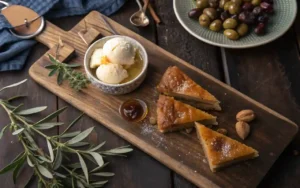While loukoumades and baklava typically take the spotlight, Greece is home to an array of delicious regional desserts that seldom are featured on menus of international restaurants. From island-inspired dishes to delicacies from mountain villages these sweets are a reflection of traditional recipes, local ingredients and even stories.
In this article, we’ll take you on a tour of Greece’s lesser-known dessert landscape, revealing hidden gems worth exploring—or recreating in your own kitchen.
Cretan Sweets: Rustic, Simple, and Honey-Infused
Kalitsounia
These little pastry cakes filled with nuts or cheese are usually served at Easter, but they are also enjoyed all year round in Crete. The sweet ones are filled with mizithra and are flavorings include citrus zest or cinnamon.
Sfakianopita
A thin cheese cake drizzled with honey and traditionally pan-fried. While technically a pie it’s usually eaten as dessert in rural areas.
Xerotigana
Fried pastry spirals, drenched in sugar and sprinkled on top with sesame seeds. Similar to diples in their preparation but with an added Cretan twist.
Compare styles with Modern Greek Dessert Recipes
Sweets from Northern Greece and Thessaloniki
Trigona Panoramatos
A speciality of Thessaloniki with a triangle shape, these filo pastry are filled with custard-like cream and then soaked in syrup. The flaky texture and the fillings are rich and make them a popular local dish.
Kazan Dibi
Originally originated from Istanbul but is widely used across Northern Greek cities. A milk pudding that is caramelized and often served with cinnamon.
Politiko Karydopita
A sweet walnut cake with syrup that is that is flavored with orange and cloves inspired from Constantinopolitan (Istanbul Turkish) food.
See how they contrast with Classic Greek Dessert Recipes
Island-Inspired Pastries
Pasteli (Multiple Islands)
In in the Cyclades and Dodecanese Sesame as well as honey bar are easy but calorie-dense. They are often consumed as a snack or dessert.
Amygdalota (Chios, Hydra, and Cyclades)
Soft almonds flavored with citrus or rosewater, formed into balls or pears. They are a common sight at weddings and events of religious significance.
Moustalevria (Santorini, Peloponnese)
A dessert made from grape must during the harvest season of wine. It is thickened with flour and flavored with cinnamon and cloves.
Regional Ingredients and Styles
- The cheese (mizithra, antihotyro) is commonly found in sweet pies.
- The grape must is a typical sweetener in Peloponnesian desserts
- Honey and sesame are the most popular Cycladic as well Dodecanese sweets
- Mastic and rosewater are used to create scent to enhance the scent of Chios along with the North Aegean
How to Find These Sweets in Greece
- Bakeries in smaller towns usually have home-made versions that aren’t available in the big-city patisseries
- Festivals of religion along with local celebrations are the ideal times to test them
- Markets for regional food sell pasteli packaged in boxes amygdalota, must, and amygdalota puddings
Return to The Ultimate Guide to Greek Desserts
Frequently Asked Questions
Are these regional desserts hard to make at home?
Some, such as pasteli and amygdalota are simple to replicate. Others, like moustalevria, require specialized ingredients.
Can I find these outside Greece?
specialty Greek bakeries, or even online shops may have some, but the majority are limited to specific regions.
What makes them different from national favorites like baklava?
simple recipe, local ingredients and often the absence of filo or syrup distinguish regional sweets from those that are national staples.





1 thought on “Regional Greek Desserts You’ve Probably Never Heard Of”
Comments are closed.